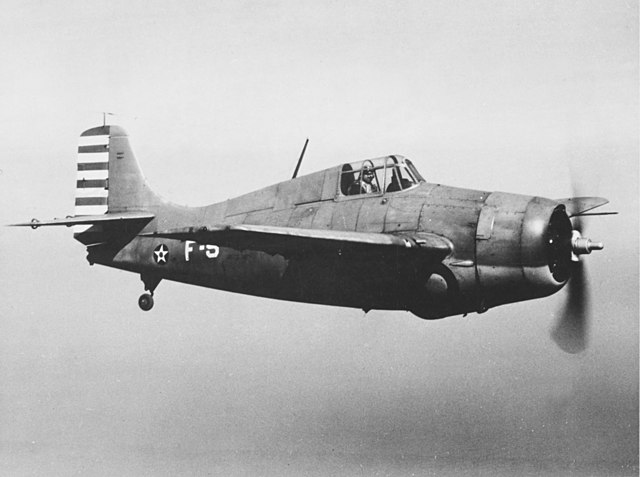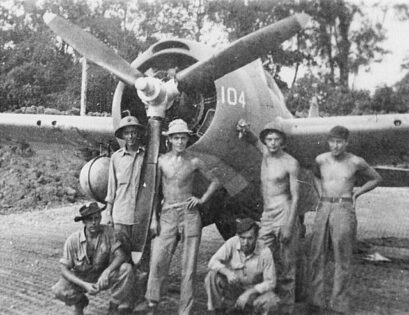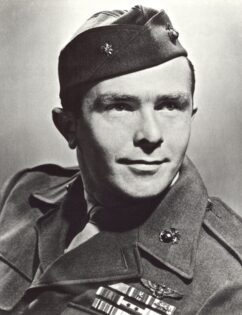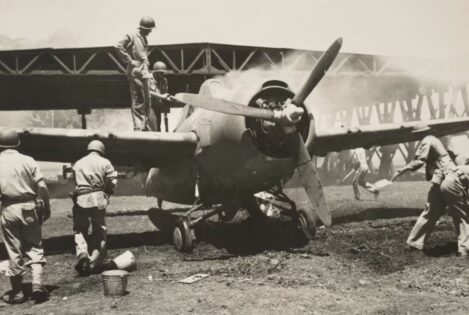
As a young second lieutenant in 1943, James Swett embarked on his first combat mission at the age of 22. Within 15 minutes, he was a fighter ace with seven enemy kills to his credit.
Swett arrived for duty in February 1943 at Henderson Field on Guadalcanal Island in the Solomon Islands chain, as a pilot with Marine Fighting Squadron 221 (VMF-221). By early April, he had gone on patrol few times in his Grumman F4F Wildcat, but saw no action.
The DOD’s Katie Lange writes about what happened next.
On April 7, 1943, Swett’s unit had already flown two missions when they were called into action against about 150 Japanese aircraft that were spotted heading for the U.S. naval fleet in Tulago, an island about 30 miles from Guadalcanal’s Henderson Airfield.

Wildcat and crew on Guadalcanal, 1943.
Swett and three other F4F Wildcat pilots took off to intercept a formation of 15 enemy bombers. Swett said in a 2003 Library of Congress Veterans History Project interview that the bombers were being escorted by numerous Zero fighter aircraft.
Ignoring flak from the American ships below him, Swett dove toward three of the bombers, taking them out with accurate and deadly fire. During that attack, Swett said an anti-aircraft shell put a hole in one of his aircraft’s wings, so he disengaged from the fight until he determined his aircraft was OK to continue.
“I was headed to getting away from the damned anti-aircraft when I found a whole bunch of [enemy] dive bombers trying to get together,” Swett said in his Library of Congress interview. “They were scattered all over the sky.”
Swett immediately jumped into action to attack the five enemy bombers. He said he flew below the enemy aircraft so their tail gunners couldn’t shoot him, then he would aim his plane’s nose up and let off short bursts from his machine gun to take them out.

James Swett
“I would go to the next one and do the same thing,” he said.
Swett shot down four, then tried to close in on a fifth.
“Then I got over-confident,” Swett said of that attempt. “The rear gunner stuck his gun practically in my face and let me have it. [It] messed up my windshield. Sight glass and plastic were flying all over the place.”
He said he managed to kill the tail gunner before he ran out of ammunition. The enemy aircraft’s remaining gunners continued their assault, hitting Swett’s engine and partially disabling it.
Swett suffered injuries to his face, and he couldn’t see well because of spouting engine oil, but he kept firing at the bomber until the smoking aircraft disappeared into a cloud. According to Marine Corps records, U.S. soldiers later found the crashed enemy aircraft with its dead crew members inside. However, the aircraft was apparently never added to Swett’s tally.
After the enemy plane disappeared, Swett tried to make it back to Henderson Airfield, but his engine cut out over Tulagi’s harbor, so he had to ditch in the water.
“I knew that I was in deep trouble, so I just eased it down. … My flaps were inoperable. I just made a regular water landing, but the airplane hit and bounced and then dove for the water,” Swett remembered. “I went down, I don’t know, maybe 20 feet or something. I was struggling to get out of the damned thing and finally did. I popped my Mae West [inflatable life preserver] and came to the surface.”
The hard landing broke his nose. Thankfully, he was quickly rescued by a small boat of natives from a nearby island before he spent too much time in the shark-infested waters. Eventually, he was transferred to a hospital in Guadalcanal for treatment.
On his first combat flight, Swett was credited with destroying seven enemy bombers. About six months later, on Oct. 12, 1943, he received the Medal of Honor for his courageous actions.

Wildcat and crew.
He continued to fly air support missions across the central Solomons through most of 1943, destroying several more enemy aircraft before the Japanese were forced to turn their attention toward other island chains.
During one battle over New Georgia Island, Swett was shot down again. This time, he spent four days in a rubber raft with only chocolate bars and coconuts for sustenance before he was rescued by locals in a canoe and taken to safety.
Swett returned to the U.S. in December 1943. About a year later, his unit returned to the Pacific to serve on the aircraft carrier USS Bunker Hill, where he saw further action at Iwo Jima and Okinawa while flying F4U Corsairs.
By the end of the war, Swett had been credited with downing 15.5 enemy aircraft. Aside from the Medal of Honor, he’d also earned two Distinguished Flying Crosses, two Purple Hearts and four Air Medals.
James Swett Medal of Honor Citation
For extraordinary heroism and personal valor above and beyond the call of duty, as division leader of Marine Fighting Squadron 221 with Marine Aircraft Group 12, 1st Marine Aircraft Wing, in action against enemy Japanese aerial forces in the Solomons Islands area, 7 April 1943. In a daring flight to intercept a wave of 150 Japanese planes, 1st Lt. Swett unhesitatingly hurled his 4-plane division into action against a formation of 15 enemy bombers and personally exploded 3 hostile planes in midair with accurate and deadly fire during his dive.
Although separated from his division while clearing the heavy concentration of antiaircraft fire, he boldly attacked 6 enemy bombers, engaged the first 4 in turn and, unaided, shot down all in flames. Exhausting his ammunition as he closed the fifth Japanese bomber, he relentlessly drove his attack against terrific opposition which partially disabled his engine, shattered the windscreen and slashed his face. In spite of this, he brought his battered plane down with skillful precision in the water off Tulagi without further injury.
The superb airmanship and tenacious fighting spirit which enabled 1st Lt. Swett to destroy 7 enemy bombers in a single flight were in keeping with the highest traditions of the U.S. Naval Service.